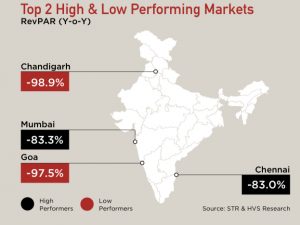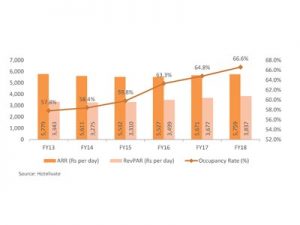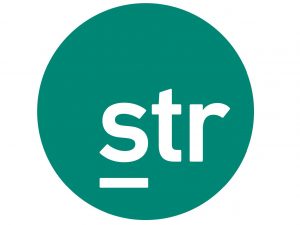While RevPAR has been low throughout the country, Chennai and Mumbai have been the top performers ( with -83% and -83.3% RevPAR YoY) in May 2020, according to HVS ANAROCK monthly newsletter, H2O.
Read More »Hotel sector to see a decline in revenue by INR 90,000 cr in 2020: HVS ANAROCK
The Indian hotels sector has come to a standstill in the last one month, with most of the hotels partially or completely shut. HVS has revised previous estimates of the overall revenue loss that the industry will face in 2020. The overall revenue of the Indian hotels sector is expected to decline by approximately INR 90,000 cr in 2020, reflecting an erosion of 57% compared to last year. RevPARs in the organized segment are expected to decline by approximately 58%. Occupancy is expected to decline by 31.6 per cent. In the organised sector the loss is expected to be INR 40,309 cr; in the semi organised sector the loss is expected to be INR 8,379 cr and in the unorganised sector it is expected to be INR 41,126 cr. The source for the above data is HVS Research as on 17 April 2020. The industry has not witnessed such an unprecedented decline in RevPARs in the last 2 decades, since HVS has been recording this data. The unorganised segment, which is 10 times the size of the organized segment, is also anticipated to witness a similar quantum of decline. COVID-19 is a disruption that nobody anticipated, but it is now time to use the learnings from this disruption and plan for the new realities beyond COVD-19
Read More »Occupancy rates for five-star hotels witnesses growth of 240 basis points YoY during FY18
Occupancy rates for five-star hotels witnessed the sharpest growth of about 240 basis points y-o-y during FY18. This was followed by three-star hotels that registered a growth of about 200 basis points and four-star hotels that registered a growth of 180 basis points during FY18, while the five-star hotels witnessed lower growth of only 110 basis points y-o-y. Two-star hotels however, witnessed a decline of about 10 basis points in their occupancy rates during the year. Also, two-star hotels witnessed the maximum growth in the group in average room rates increasing by about 8.5 per cent y-o-y during FY18. This was followed by three-star hotels that registered a growth of about 5 per cent y-o-y in FY18. Four-star and five-star hotels recorded a growth of 3 per cent y-o-y each in average room rates. Apart from that, each star category witnessed a y-o-y increase in RevPAR in FY18, with the three-star category leading the pack, recording a 8.2 per cent growth during the year.
Read More »India’s hotel occupancy highest in May in a decade
According to the latest monthly data from STR Global, India’s nationwide occupancy increased 5.4 per cent year-on-year to 61.4 per cent last month, which marked the highest absolute occupancy level for a May in India since 2007. And this extra demand is allowing hoteliers to hike their rates; India’s average daily rate (ADR) climbed 3.5 per cent to Rs. 5,406.77 (approx. $84) in May. These two factors combined to raise nationwide revenue per available room (revPAR) by +9.1 per cent to Rs. 3,319.71. RevPAR has now increased 4.2 per cent during the first five months of 2017, driven by strong domestic tourism and rising affluence among India’s growing middle class. Specifically in May, hotel demand was supported by the Indian Premier League cricket and the African Development Bank annual meetings in Ahmedabad.
Read More » Tourism Breaking News
Tourism Breaking News



